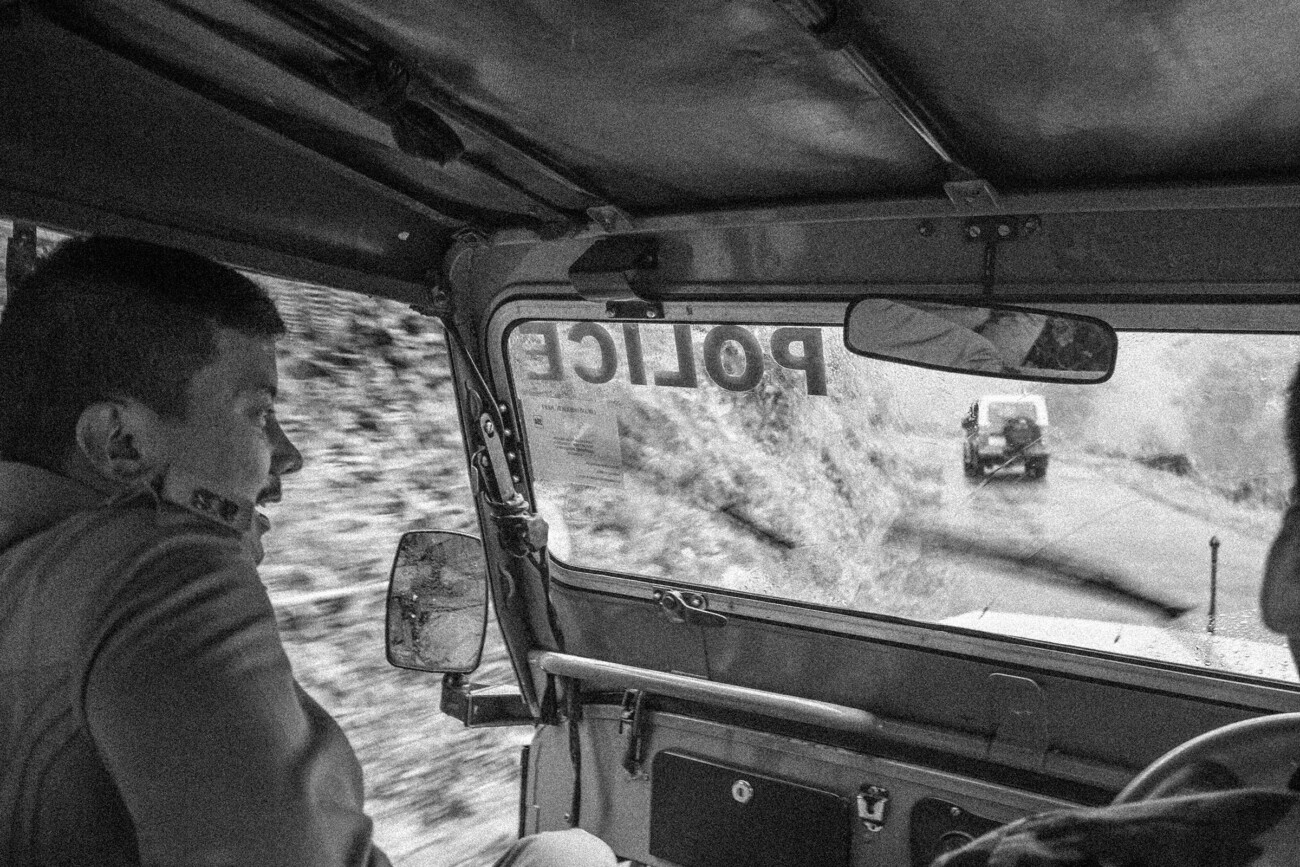
Photo: Praveen Chettri / June, 2018
In 2008, Sikkim earned the dubious distinction of being the state with the highest suicide rate (48.2) in the country and in the last decade the state has continually been referred to as the ‘Suicide capital of the Northeast’.
Death affects everyone. WHO data indicates approximately 700,000 persons worldwide die by suicide every year (WHO Factsheet). This roughly corresponds to one death by suicide every forty seconds. Suicide is one of the many problems Sikkim is grappling with. Although the percentage share in total suicides is negligible owing to its small population, the rate of suicide (the number of suicides per one lakh population) is significantly high. In 2008, Sikkim earned the dubious distinction of being the state with the highest suicide rate (48.2) in the country and in the last decade the state has continually been referred to as the ‘Suicide capital of the Northeast’. Table 1.0 highlights why such a label has been attached to Sikkim. Over the span of thirteen years (2008-2020), Sikkim has consistently registered the highest suicide rates, followed by Tripura in second position. Meanwhile, Nagaland and Manipur report some of the lowest suicide rates in the country. Such alarming statistics point at rising challenges posed by the socio-economic transitions underway in the state.
Figure 1.0: Rates of Suicide- All India and Sikkim, 2008-2020
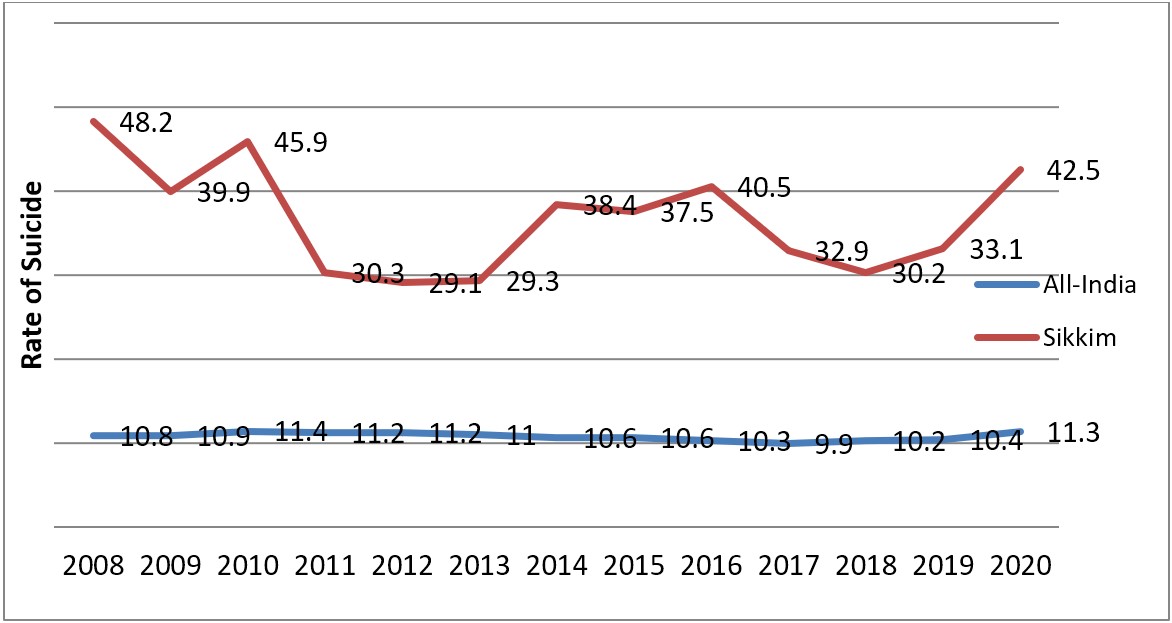
Figure 1.0 draws a comparison between the rates of suicide at the All-India level and Sikkim over a span of thirteen years, respectively. The above data clearly reflects the dismal scenario in Sikkim about the number of lives being lost to suicides.
Table 1.0: Rates of Suicide- Northeast India, 2008-2020
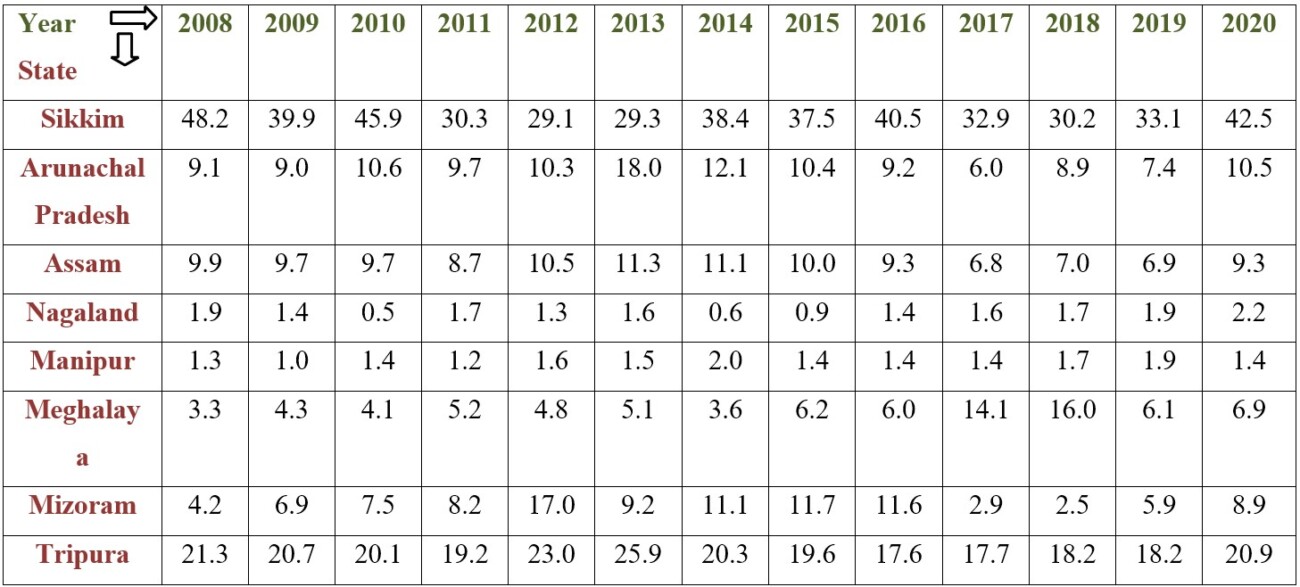
On August 5, 2022, a 27-year-old Sikkimese girl was found hanging in a rented apartment in Bengaluru, South India (Sikkim Chronicle,2022). The news attracted scant attention. When suicide cases were initially reported in the local media, citizens were curious to know the causes behind this phenomenon. With time, curiosity seems to have faded among the public. Recently, there has been much deliberation on this topic among policy makers, medical professionals, academic scholars, and civil society. Sadly, suicide is still looked at from a sanitized distance and those who have lost a loved one to suicide prefer to remain silent.
Table 1.1: District wise break-up of Unnatural Deaths in Sikkim, 2000-2015

Together, this means that Sikkim lost 1,178 lives to suicide wherein the victims were from the 15-44 years age bracket, 72.53 percent (NCRB, 2006-13). The sex-wise break up follows a similar trend. More men die of suicide than women.
The State Police Records (SPR) data does not have a separate category for suicides. Unnatural deaths include death by hanging, consumption of poison, drug overdose, burn, drowning, unidentified dead body, accidental death, fall from height, over alcoholism, miscellaneous, and unknown causes. The district-wise break-up of unnatural deaths reveals East district as reporting the highest number of deaths (2,227 cases). West and South districts seem to be closely tied with 930 and 902 cases, respectively. North district reported only 304 deaths (SPR, 2000-15). When considering the percentage share of unnatural deaths to the district specific population, North Sikkim is at par with the West and South districts. This can partly be explained in terms of numerous motor vehicle accidents being reported from North Sikkim.
In terms of the age-group, NCRB records indicate that out of a total of 1,624 victims, a staggering 692 casualties were from the 15-29 years category. This was followed by 486 victims from the 30-44 years age group. Together, this means that Sikkim lost 1,178 lives to suicide wherein the victims were from the 15-44 years age bracket, 72.53 percent (NCRB, 2006-13). The sex-wise break up follows a similar trend. More men die of suicide than women. The gender paradox in suicide studies highlights more women attempt suicide, but suicidal deaths are higher among men (Canetto, 1998). One of the explanations for this trend could perhaps be found in the patriarchal structure which gives unprecedented authority to men, who in times of hardship, refrain from voicing their problems or seeking help. In Sikkimese society too, this idea of ‘masculinity’ seems to be taking a toll on their lives. While social norms and values are more oppressive for women, they are conditioned to face and accept these adversities from a young age. Hence a suicide attempt may be a cry for help. Suicide cases show little evidence that persons committing suicides in Sikkim use a particular method because it holds a special fascination for them but death by hanging is the most common method (NCRB).
Figure 1.1: Educational Status of Victims of Suicide, Sikkim (2016-20)
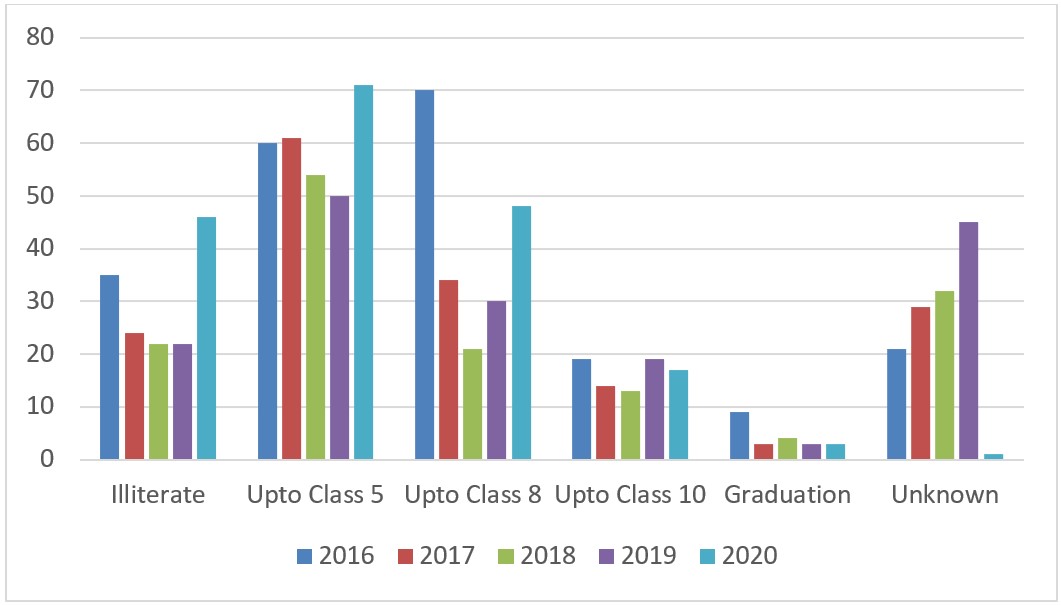
The academic profile of the victims of suicide shows a slight shift in trend. Between 2000 and 2012, suicide was frequent among the illiterate, followed by those who had studied up to primary level, and middle school (NCRB). Between 2016-20, suicide was highest among those who had studied up to primary or middle school, followed by the illiterates. As individuals attain higher degrees, the probability of suicide seems to decrease. This can be interpreted from Figure 1.1 which shows that out of 1,181 victims of suicide, 22 persons were graduates and above, 296 victims had studied up to Class 5, 294 victims had completed middle school education, and 149 were illiterates (NCRB, 2016-20). In Sikkim, the social status hierarchy seems to be inversely proportional to the suicide rate. This means that education is actually a positive tool in controlling suicide rates. Sikkim has one of the highest literacy rates at 82.2 percent. Male literacy stood at 87.3 and female literacy at 76.4 percent, respectively (Census 2011). On the one hand, increased access to education has led to a competitive job market, while, on the other hand, a large percentage of suicide victims are semi-educated. The focus now needs to shift towards the quality of education, to re-evaluate the present curriculum and to assess whether those considered literate are equipped to enter the job market, or are the majority dropping out of school, adding to their frustration and stress of coping with the demands and responsibilities of adulthood. Based on NCRB data for 2000-12, certain professions in Sikkim are at a higher risk of suicide than others. The vulnerable groups include self-employed individuals (engaged in business/professional activities/agriculture), unemployed persons, private sector employees and housewives. According to the latest figures, unemployed persons constituted the highest number of victims of suicide in Sikkim (104), followed by students (55) and those directly or indirectly engaged in agriculture (38) (NCRB, 2020).
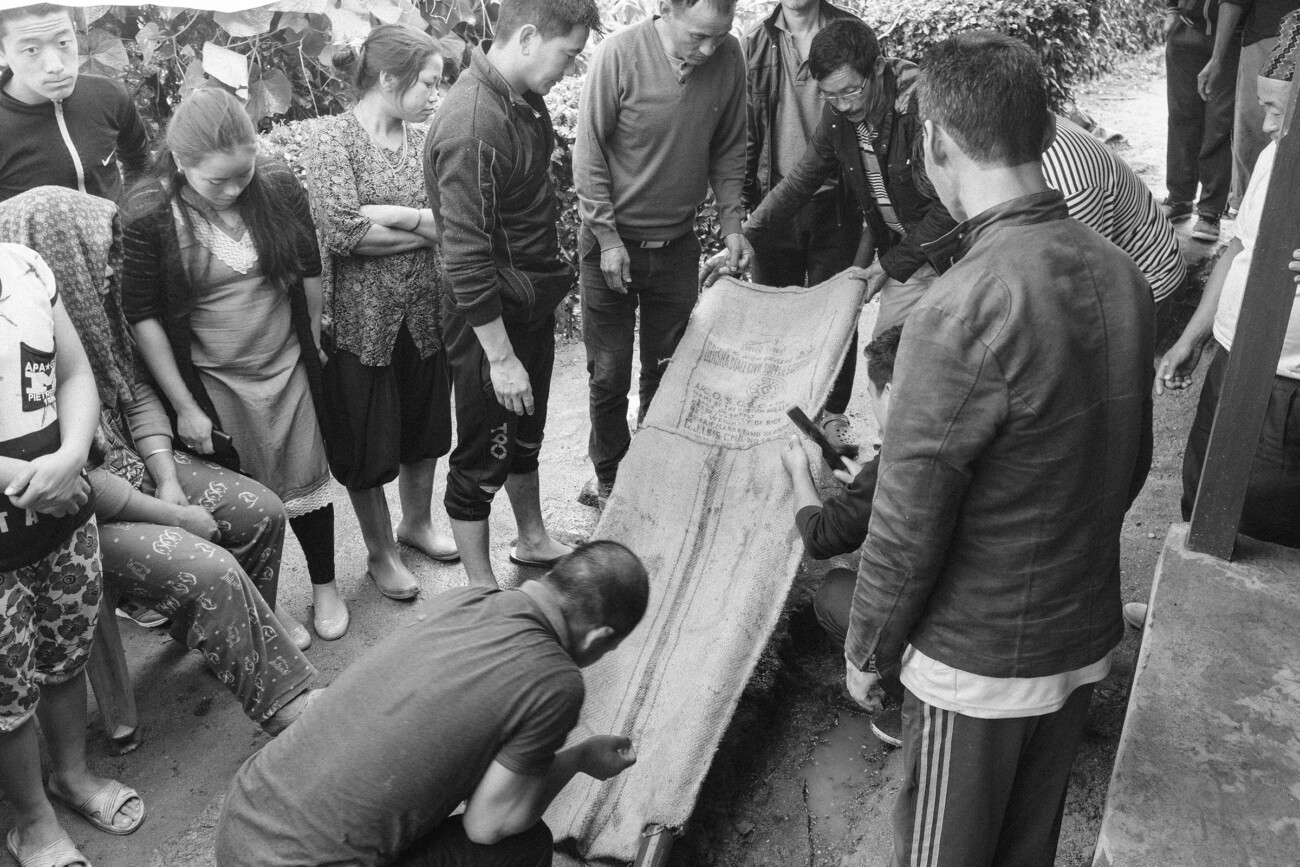
Photo: Praveen Chettri / June, 2018
The Sikkimese society is undergoing a rapid transformation in its socio-economic and political structure, with new stratifications based along lines of class, occupation, income, property ownership or political power. Despite the negligible size of the domestic market and net exports from the state, the GDP of Sikkim is relatively high as a result of its small population. The per capita net income has improved significantly from Rs. 158,667 in 2011-12 to Rs. 297,765 in 2017-18 (DESM&E). However, the benefits of an increased GDP have not trickled down to all sections of society. With significant improvements being recorded in areas such as health, literacy and tourism, there is a possibility that progress might have brought new forms of deprivation and problems. In spite of economic growth, challenges like drug addiction, alcoholism, suicide and domestic violence have been rising in Sikkim (NFHS-5, 2019-21).
An interplay of various factors results in suicide. For example, while unemployment may not be a direct cause of suicide, the workplace is a vital locus of social ties and shared goals. Unemployment can have a triggering effect, such as inducing vulnerability, provoking relationship difficulties or financial problems (Blakely, 2003). Being unemployed can undermine their position in society. Cultural lag is also an apparent social phenomenon experienced by the Sikkimese people. The term was first coined by W. F. Ogburn (1922) to describe the notion that material culture and non-material culture do not occur equally in any given society. While material culture has the tendency to evolve and change rapidly, non-material culture are the intangible aspects such as thoughts, ideas etc. which are resistant to change and hence take longer to adapt to a new set up. The Sikkimese society has traditionally been an extremely close-knit community but exposure to western culture, increase in female education, modernisation are some of the factors which have broken the traditional link between the individual and society. The 13.2 percent rise in rural-urban migration pattern, between 2001-11, is indicative of a significant change in the aspirations of the people (Census 2011).
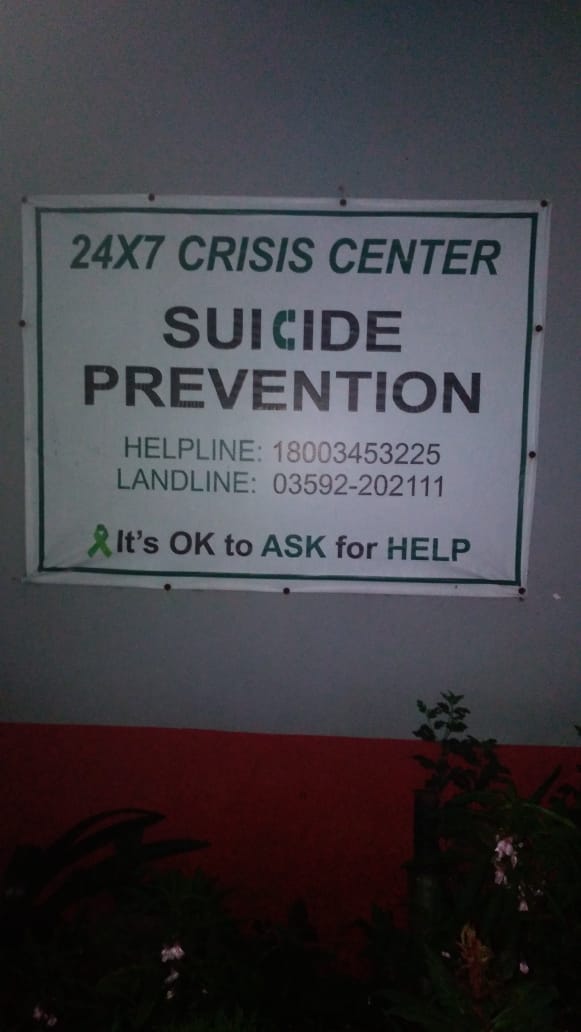
At present, urgent action is required for the implementation of a national suicide prevention strategy in India which could potentially serve as a guide against curbing suicidal deaths. Such a policy can direct the states to come up with their own prevention strategies as per local needs.
Numerous programmes and policies have been launched by the State Government to address the issues of suicides in Sikkim. For instance, a 24/7 Suicide Helpline was set up in 2015 by the Department of Health and Family Welfare, Government of Sikkim. The Helpline has two operational numbers- 1800-345-3225 and 03592-202111. The helpline is manned by eight individuals, 6 males and 2 females. Based on his participation in the Helpline, Mr. K. C. Nima, Team Leader/Coordinator, Suicide Helpline mentioned that recurring problems ranged from domestic issues, drug abuse to alcoholism. The Helpline has managed to save around 7-8 lives so far but he feels they can achieve a lot more. He states that working in this field has been a humbling experience. A big challenge has been dealing with the mental health issues of the helpline staff who operate in a silent workspace, waiting for a distress call which can range from being a cry for help to accusations, challenges etc. “We do not have our own ventilation”, he stressed. This was a thought that troubled him during the CoVID-19 lockdown when his own mental health condition started deteriorating. In 2019, the Dept. of Health & Family Welfare, Govt. of Sikkim partnered with NIMHANS, Bengaluru to launch the Sikkim Suicide Prevention and Action Network (SPAN) project. The Department has also initiated a Life Skills Education (LSE) programme to promote healthy life skills and coping among the youth which is still in an infant stage. Mental Health Services (MHS) are also provided through Primary Health Centres (PHCs). Routine outreach efforts are conducted in the districts to dispel myths and ignorance about mental illness, suicides etc.
At present, urgent action is required for the implementation of a national suicide prevention strategy in India which could potentially serve as a guide against curbing suicidal deaths. Such a policy can direct the states to come up with their own prevention strategies as per local needs. In the absence of a proper monitoring authority, the creation of a State Suicide Registry of Sikkim (SSRS) is of paramount importance. Such a registry can provide a comprehensive database on attempted and completed suicides in the state with an endeavour to gather more detailed and timely data on suicides with access to in-depth information on the social, cultural, medical, educational and economic profile of the victims of suicide, authorities can assess the root cause of suicides in the state while identifying recurring themes. Such a registry can function in collaboration with multiple stakeholders such as policy makers, doctors, academicians, researchers etc. In Sikkim, the high figures of unemployed and self-employed casualties and the low number of suicides among government servants reveal that the latter provides a safety net against suicide. What are the underlying reasons that protect people working in the public sector from suicides? Additionally, there is a dire need to re-evaluate the present curriculum and design in the education system to suit the needs of contemporary times. Life Skill Education (LSE) must be imparted to adolescents and young adults in schools and colleges as part of the educational experience. More vocational and livelihood oriented academic programmes need to be introduced so that a school or college drop-out has the minimum training to earn a living and provide for his/her family. Youth inclusion in suicide prevention efforts is imperative to promote positive self-image and inculcating appropriate help seeking behaviours. Community-based approaches could prove to be effective in suicide prevention. The employment of locals as resource persons and partnership with Non-Governmental Organisations (NGOs) is important as they have knowledge of the strengths and needs of a particular community or area and can connect to a wider audience. This can help in finding potential solutions. Awareness generation is an important component of suicide prevention efforts. In Sikkim, talking about suicide by those who have experienced the loss is uncommon. Openness and discussion on the topic is vital for proper diagnosis of the problem.
*The National Crime Record Bureau (NCRB) annual publication, titled “Accidental Deaths and Suicides in India”, is the most comprehensive databank available with the Government of India on the subject.
- Blakely T.A., Collings SC, Atkinson J. Unemployment and suicide. Evidence for a causal association? J Epidemiol Community Health. 2003 Aug; 57 (8): 594-600.
- Canetto SS, Sakinofsky I. The gender paradox in suicide. Suicide Life Threatening Behavior. 1998; 28 (1):1–23.
- Census of India. Office of the Registrar General & Census Commissioner, India. India, 2011.
- Crime Branch, Police Department, Government of Sikkim
- DESM&E, Government of Sikkim https://www.desmesikkim.nic.in/page/27#content-page
- Durkheim, Emile. 1966. Suicide: A Study in Sociology. John A. Spaulding (trans.) with an introduction by George Simpson (ed.), The Free Press, New York.
- National Crime Record Bureau. Annual Publications. Accidental Deaths and Suicides in India, 2000-20
- National Family Health Survey-5, 2019-21. http://rchiips.org/Nfhs/NFHS-5Reports/Sikkim.pdf
- Reserve Bank of India. Handbook of Statistics on the Indian Economy, 2020-21. https://www.rbi.org.in/scripts/AnnualPublications.aspx?head=Handbook%20of%20Statistics%20on%20Indian%20Economy
- Sikkim Chronicle, 8th August 2022, “27 year old Sikkimese girl commits suicide in Bangalore; CM intervenes to bring her mortal remains home”
- World Health Organisation, 2021. Suicide worldwide in 2019: global health estimates (https://www.who.int/publications/i/item/9789240026643).
Nancy Choden Lhasungpa is an Assistant Professor, Department of Sociology, Nar Bahadur Bhandari Government College Tadong, Gangtok, Sikkim.
She received her M.Phil and PhD from the Centre for the Study of Social Systems, Jawaharlal Nehru University. She has a Double Masters degree from Delhi School of Economics (Sociology), Delhi University and Kings College, University of Aberdeen (International Relations), Scotland, United Kingdom.
Her research interests include culture, gender, globalisation and social change, migration and diaspora. She has contributed research papers in areas of her interest to books and professional journals.
2 comments on “SUICIDE AND SUICIDAL BEHAVIOUR IN SIKKIM: AN OVERVIEW”
Leave a Reply
Latest Posts
Latest Comments
No 'Comments_Widget_Plus_Widget' widget registered in this installation.


In my point of view, The govt of sikkim, should take more initiative and launched more policies and programes and should have counseling classes as compulsory in the school and colleges, so that the students can share their feelings personally, 🙏
Nancy Lhasungpa's research doesn't go deep enough, but it does identify unemployment, alcoholism and drug use as important factors behind high suicide rates in Sikkim, particularly among men. In another article by Mahendra Lama in the Kathmandu Post, similar reasons have been identified in Nepal and Bhutan, though Sikkim seems worse afflicted. The macho self image of men has also been identified as a reason, though the author should have been more explicit about the role of sexual inadequacy in men and the resultant marital conflicts pushing men to suicide.
Alcohol consumption in excess is a concomitant of unemployment. And it intensifies marital conflict, leading to make and female suicides.